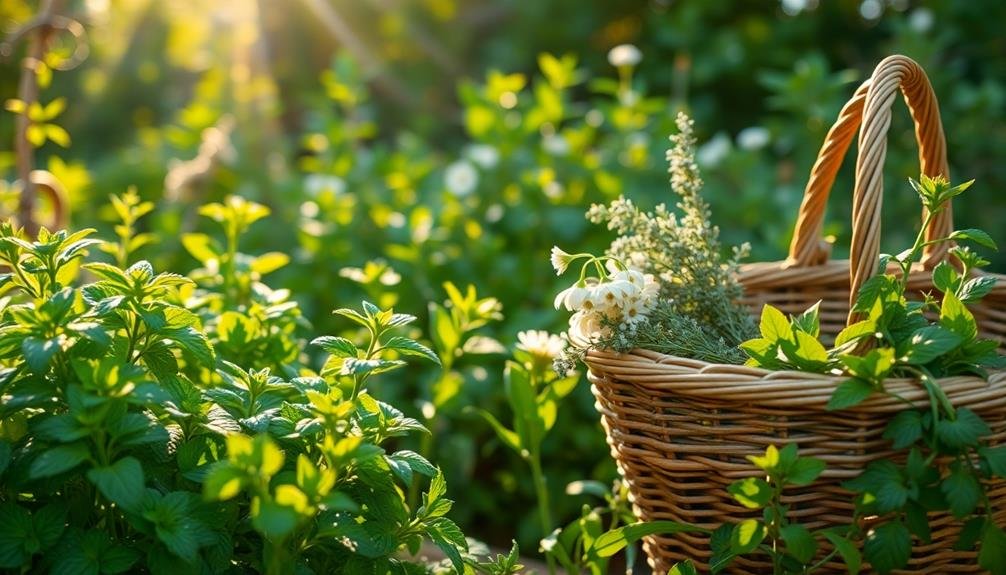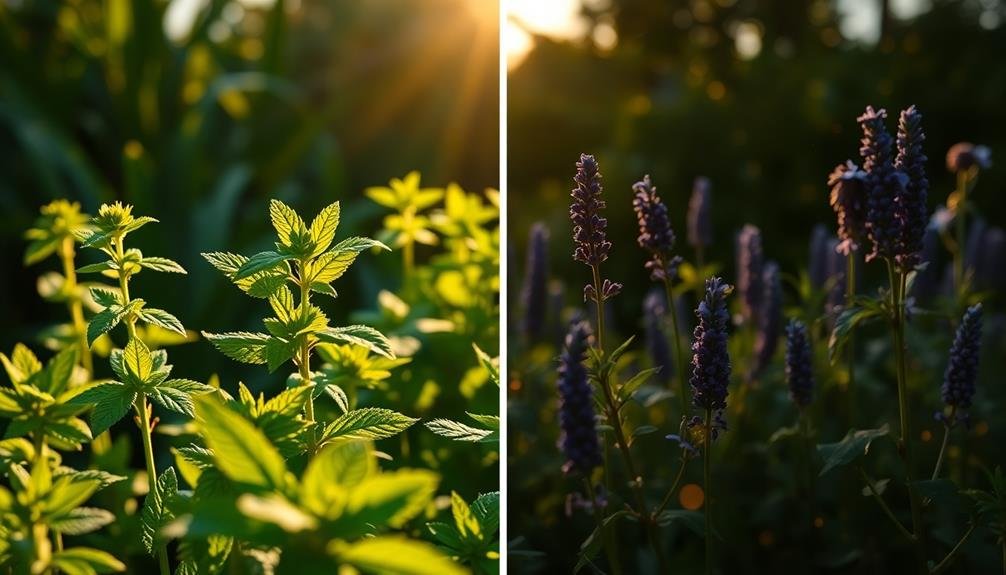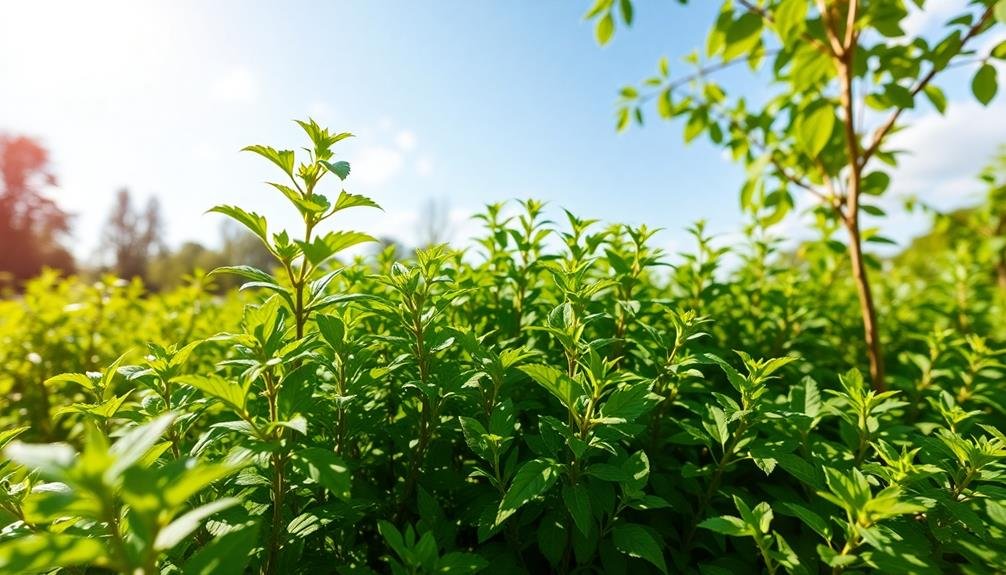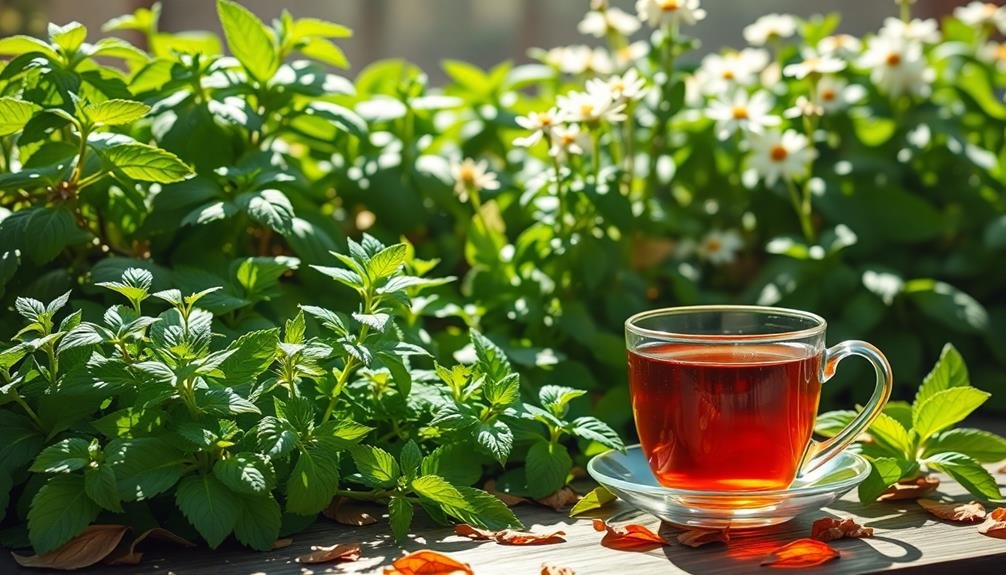To brew the perfect tea, pick your herbs in the morning after the dew evaporates but before the sun is high. This timing maximizes essential oils, enhancing flavor. Aim for vibrant green leaves with a strong aroma—these are signs the herbs are ready. Each season has its best herbs; for instance, basil thrives in spring, while chamomile prefers summer. Tailor your harvest to the time of day: choose invigorating herbs in the morning and calming ones for evening blends. For more tips on when and how to pick your herbs, there's plenty more to explore.
Best Time to Harvest

When it comes to harvesting herbs for your perfect tea blends, timing is everything. You want to make sure you're picking your herbs at their peak flavor and potency. Generally, the best time to harvest is in the morning after the dew has evaporated but before the sun gets too high in the sky. This way, the essential oils are concentrated, giving your tea a more robust flavor.
Look for herbs that are vibrant and healthy. Avoid those that show signs of wilting or browning, as they won't contribute to the quality of your blends.
For leafy herbs like mint or basil, pick the leaves when they're young and tender; they usually pack the most flavor. On the other hand, if you're harvesting flowers like chamomile, wait until they're fully open for the best aroma and taste.
Don't forget to use clean, sharp scissors or shears to make clean cuts. This minimizes damage to the plant, ensuring it can continue to thrive and produce more herbs.
Optimal Seasons for Herbs
Knowing the ideal seasons for harvesting your herbs can greatly enhance the quality of your tea blends. Each herb has its own peak time, and picking them at the right moment guarantees you capture their full flavor and potency.
Here's a quick guide to help you:
- Spring (March to May): This is the best time for tender herbs like basil, cilantro, and dill. They thrive in the warmer weather, giving you vibrant flavors for your tea.
- Summer (June to August): Herbs like mint, lemon balm, and chamomile flourish during the hot months. Harvest in the morning after the dew dries for maximum essential oils.
- Fall (September to November): This season is great for heartier herbs like rosemary, sage, and thyme. The cooler temperatures intensify their flavors, making them perfect for autumn-inspired blends.
- Winter (December to February): While most herbs are dormant, you can still harvest hardy ones like winter savory and some varieties of sage. Use these to create warm, comforting teas during the chilly months.
Morning vs. Evening Picks

When choosing herbs for your tea, consider how they affect your day.
Morning blends often include invigorating flavors like ginger and lemon, while evening options focus on relaxation with herbs such as chamomile and lavender.
Understanding these differences can help you craft the perfect tea for any time.
Morning Flavor Profiles
Starting your day with the right tea blend can set a positive tone, energizing both body and mind.
When crafting your morning tea, consider flavor profiles that awaken your senses and provide a boost. Here are four key herbs to think about for your morning blends:
- Peppermint: Its revitalizing aroma invigorates and stimulates mental clarity, making it perfect for those groggy mornings.
- Ginger: Known for its spicy kick, ginger not only warms you up but also aids digestion, ensuring you're ready for the day ahead.
- Lemon Balm: This herb offers a citrusy flavor that brightens your blend, while its calming properties help reduce morning anxiety.
- Green Tea: A staple for many, green tea provides a gentle caffeine lift without the jitters, keeping you alert and focused.
Evening Relaxation Herbs
As the day winds down, selecting the right herbs for your evening tea can help you unwind and prepare for a restful night. Unlike morning herbs that energize and invigorate, evening relaxation herbs focus on soothing your mind and body.
Chamomile is a classic choice; its gentle, calming properties can ease tension and promote sleep.
Lavender is another excellent option, known for its relaxing aroma and ability to reduce anxiety. You might also consider lemon balm, which not only tastes delightful but can help alleviate stress and enhance your mood.
If you're looking for something more robust, try valerian root. This herb has been used for centuries to combat insomnia and improve sleep quality.
Remember to blend these herbs according to your preferences. A calming mix of chamomile and lavender can create a serene experience, while adding lemon balm can intensify the relaxation.
As you prepare your evening tea, take a moment to breathe deeply and enjoy the process. This simple ritual can transform your evening routine, helping you drift into a peaceful slumber, ready to embrace a new day.
Signs of Herb Readiness
Knowing the signs of herb readiness can make all the difference in your tea blends. When you pick your herbs at the right time, you'll capture the best flavors and aromas. Here are some key indicators to look for:
- Color: Check the leaves for vibrant colors. Herbs like basil should be a rich green, while mint should display bright, healthy foliage. Dull or yellowing leaves indicate they're past their prime.
- Aroma: Crush a leaf between your fingers. If it releases a strong, pleasant scent, it's ready to be harvested. A lack of fragrance can signal that the herb isn't yet fully developed.
- Size: Look for mature leaves. Each herb has its ideal size; for instance, you want basil leaves to be about the size of your palm. If they're too small, give them more time to grow.
- Flowers: For many herbs, like oregano and thyme, you want to avoid flowering. Once they bloom, the flavor often diminishes, so harvest before the flowers appear for the best taste.
Ideal Weather Conditions

When you're growing herbs for your perfect tea blends, the weather can make all the difference.
Temperature and humidity impact your herbs' flavor, while the ideal time of day for harvesting can enhance their potency.
Keep seasonal considerations in mind to guarantee your herbs reach their full potential.
Temperature and Humidity Impact
The interplay of temperature and humidity greatly affects the quality of your tea blends. When you're picking herbs, it's vital to take into account these factors, as they can influence flavor and potency.
Here's what you need to keep in mind:
- Temperature: Ideal picking conditions usually fall between 60°F and 75°F. Extreme heat can cause herbs to wilt, while cold temperatures may slow their growth.
- Humidity: Aim for moderate humidity levels, ideally around 50-70%. High humidity can lead to mold growth, while low humidity might dry out your herbs prematurely.
- Sunlight: If it's sunny out, try to pick your herbs in the early morning or late afternoon. This timing helps preserve essential oils, enhancing the flavor of your tea blends.
- Weather Patterns: Be mindful of recent weather changes. After a rain, herbs are often more flavorful, but if it's been too wet, they could have excess moisture, affecting their shelf life.
Optimal Time of Day
Picking herbs at the right time of day can greatly enhance the flavors in your tea blends. Early morning is often the best time for harvesting herbs, especially before the sun fully rises. At this hour, the dew still clings to the leaves, helping to preserve their essential oils. The air is cooler, which means the herbs are fresher and more aromatic.
As the day progresses, the sun's heat can cause essential oils to evaporate, diminishing the flavor profile of your herbs. Late afternoon or early evening can also work well, especially if the day hasn't been too hot. Just make sure to pick your herbs before dusk, as the cooling temperatures can sometimes lead to moisture buildup, impacting the quality of your harvest.
Here's a quick reference table to help you decide when to pick your herbs:
| Time of Day | Pros | Cons |
|---|---|---|
| Early Morning | Fresh, aromatic, high oils | Requires early rising |
| Late Morning | Good flavor, dry leaves | Can be warm |
| Afternoon | Convenient, easy to access | Heat may affect oils |
| Evening | Cool temperatures | Moisture buildup possible |
Seasonal Considerations for Harvesting
Seasonal changes play an essential role in determining the ideal weather conditions for harvesting herbs. You want to pay attention to the climate and timing to guarantee your herbs are at their peak flavor and potency. Here are some key considerations:
- Temperature: Aim for a cool, dry day, ideally between 60-70°F (15-21°C). This guarantees minimal moisture in the leaves, which can lead to mold during drying.
- Humidity: Low humidity levels are preferable. High humidity can cause your herbs to wilt quickly, affecting their aromatic oils and overall quality.
- Rainfall: Avoid harvesting right after a rainfall. It's best to wait until the foliage dries, as excess moisture can dilute the flavors you're after.
- Sunlight: Harvest in the morning after the dew has dried but before the sun is too intense. This time frame helps preserve the essential oils that contribute to the aroma and taste of your tea blends.
Techniques for Picking
Choosing the right herbs for your tea blends can elevate your brewing experience. When it comes to picking herbs, timing and technique are essential. Aim to harvest in the morning after the dew has dried but before the sun is too hot. This guarantees the essential oils are at their peak, giving your tea a richer flavor.
When you're ready to pick, use clean, sharp scissors or garden shears to avoid damaging the plant. Grasp the stem firmly and cut just above a leaf node, promoting new growth. For leafy herbs like mint or basil, take only the top few leaves, which are usually the most flavorful.
If you're harvesting flowers or seeds, wait until they bloom fully for peak potency. Be mindful of the plant's health; never take more than one-third of a plant at a time. This helps make sure it continues to thrive.
Storing and Drying Methods

Properly storing and drying your herbs is essential for preserving their flavor and potency. When you take the time to do it right, your tea blends will shine with vibrant aromas and tastes. Here are some effective methods to guarantee your herbs remain fresh and flavorful:
- Air Drying: Tie your herb stems in small bunches and hang them upside down in a cool, dark, and well-ventilated area. This method allows moisture to escape slowly, enhancing the flavor profile.
- Dehydrator: If you want a quicker method, use a dehydrator. Set it to the appropriate temperature for herbs, and within a few hours, you'll have perfectly dried leaves.
- Oven Drying: Spread herbs on a baking sheet and place them in an oven set to the lowest temperature. Keep the door slightly ajar to let moisture escape, checking them frequently to avoid burning.
- Storage Containers: Once dried, store your herbs in airtight containers, preferably glass. Keep them in a cool, dark place away from direct sunlight to maintain their potency for longer periods.
Frequently Asked Questions
Can I Mix Different Herbs When Harvesting?
Absolutely, you can mix different herbs when harvesting! Just make sure they complement each other in flavor and aroma. Experimenting with combinations can lead to delightful discoveries, enhancing your herbal experiences in the kitchen or for tea.
How Do I Know if Herbs Are Organic?
To know if herbs are organic, check labels for certification. Look for trusted brands or local farmers. If you can, ask about their growing practices. You'll feel more confident in your herbal choices this way.
What Tools Are Best for Picking Herbs?
To pick herbs effectively, you'll need sharp scissors or garden shears, a basket for collecting, and gloves for protection. These tools help you gather herbs cleanly, ensuring you preserve their quality and flavor for use.
Are There Any Herbs I Should Avoid?
You should avoid herbs known for toxicity, like foxglove or hemlock. Also, steer clear of plants treated with pesticides. Always research unfamiliar herbs to ascertain they're safe for consumption and won't cause adverse reactions.
How Long Can I Store Fresh Herbs Before Drying?
You can store fresh herbs in the fridge for about a week. After that, they start losing flavor and freshness. It's best to dry or use them within this timeframe for ideal taste.
In Summary
To create the perfect tea blends, timing is everything. By harvesting herbs in the morning when their oils are most potent, and during prime seasons, you'll enhance the flavor of your blends. Pay attention to signs of readiness and ideal weather conditions to guarantee the best quality. Use proper techniques for picking, and don't forget about effective storing and drying methods. With these tips, you're well on your way to brewing delicious herbal teas!





Leave a Reply